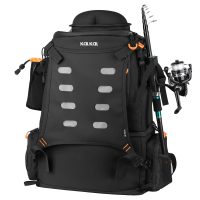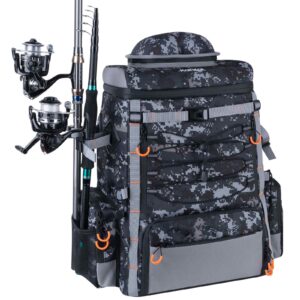Ever dream of venturing into the rugged wilderness of Wyoming, feeling invigorated by the crisp mountain air and thrilled by the distant sound of a tom turkey? For hunters seeking an unforgettable challenge, Wyoming offers a unique opportunity to pursue Merriam’s turkeys amidst breathtaking landscapes.
This guide includes everything you need to know about turkey hunting in Wyoming, from the types of turkeys you might encounter to the best locations and crucial tips for a successful expedition.
Whether you’re a seasoned hunter or embarking on your first turkey hunt, this comprehensive resource will equip you with the knowledge and strategies to make your Wyoming adventure a resounding success.
What Types of Turkey Can You Hunt in Wyoming?
There are two main types of turkeys you can hunt in Wyoming:
Merriam’s Turkey

Merriam’s turkeys are mountain turkeys and prefer habitats with open areas interspersed with scattered ponderosa pine and Douglas fir forests, or pinon-juniper woodlands. They are smaller than Eastern turkeys, with males typically weighing 18-22 pounds and females 8-12 pounds. Their body feathers are a bronzy copper color with a greenish sheen and the tail color is light buff. Also, males have a beard that is tipped with black.
Rio Grande Turkey

Rio Grande wild turkeys were introduced to Wyoming in 1996 from Oklahoma. They are found in river bottoms and breaks, and are slightly larger than Merriam’s turkeys, with males typically weighing 20-25 pounds and females 10-12 pounds. They have tan-colored tips on their tail feathers and body feathers are a rich chestnut brown color. Male turkeys have a beard that is tipped with brown or black.
While Eastern turkeys are not native to Wyoming, there have been some unofficial introductions over the years, and a small population may exist in the eastern part of the state. However, hunting for Eastern turkeys is not recognized by the Wyoming Game and Fish Department.
Wyoming Turkey Seasons In 2024
If you’re planning a turkey hunt in Wyoming this year, the spring season for 2024 is open from April 1st all the way through May 31st. The dates may vary depending on different hunt areas. View the Wyoming turkey season schedule here.
To hunt turkeys, there are two types of licenses available:
- General season license: This license allows you to hunt any male wild turkey or any wild turkey with a visible beard. It’s valid over the counter for all hunt areas except Hunt Area 2 (Black Hills).
- Limited quota license:A separate license is required for Hunt Area 2 (Black Hills) and is issued through a drawing system. It also allows you to hunt any male wild turkey or any wild turkey with a visible beard.
Where Is the Best Place to Hunt Turkey In Wyoming?
Here’s a breakdown of the most popular areas:
Public Land
- Black Hills (Hunt Area 1): This is considered the best public land area in Wyoming for turkey hunting, particularly Merriam’s turkeys. The Black Hills offer a mix of ponderosa pine forests, meadows, and canyons, which provide ideal habitat for these birds.
- Laramie Mountain Range: This range offers good opportunities for hunting Merriam’s turkeys, especially in the areas around Wheatland and Laramie. The terrain is a mix of open forests, meadows, and rocky outcrops.
- Medicine Bow National Forest: The southern portion of the Medicine Bow National Forest, between Casper and Wheatland, has scattered public lands where you can find Merriam’s turkeys.
Private Land
Private lands in eastern Wyoming, particularly near the Nebraska border, offer opportunities to hunt for Merriam’s turkeys and possibly even some Rio Grande turkeys.
If you’re specifically interested in hunting Rio Grande turkeys, eastern Wyoming may be your best bet. However, Merriam’s turkeys are still more common in this region.
Wyoming Turkey Hunting Outfitters
An outfitter is a professional guide who organizes and leads hunting or fishing trips. They possess a deep well of knowledge about their operating area, including the prime locations to find games, the local wildlife populations, and the regulations that govern hunting.
Outfitters typically have years of experience in the field and possess honed skills in scouting, tracking, and hunting techniques. They can also provide valuable insight into the behavior of the target species, which can be crucial for a successful hunt.
Service Offered By Outfitter
Outfitters can provide a variety of services, including:
- Transportation to and from the hunting areas
- Lodging and meals
- Guiding on hunting trips
- Scouting for turkeys
- Providing hunting equipment (such as calls, decoys, and blinds)
- Helping with field dressing and packing out your turkey
The cost of hiring a turkey hunting outfitter in Wyoming can vary depending on the location, the duration of the trip, the services included, and the experience of the outfitter. Generally, you can expect to pay anywhere from $1,500 to $3,000 or more for a fully guided turkey hunting trip in Wyoming.
DIY Hunting Trip vs Find an Outfitter
Should you go hunt turkey on your own or find an outfitter to arrange everything for you? Here we will evaluate the benefits and limits they have and help you choose a preferable option.
DIY Hunting Trip
👍Pros:
- Cost-effective: DIY hunts are significantly cheaper. You only pay for licenses, tags, equipment, and any transportation or camping fees.
- Sense of accomplishment: There’s a deep sense of satisfaction that comes from a successful hunt you planned and executed yourself.
- Customization: You have complete control over the hunt. You choose when, where, and how to hunt.
Cons:
- Requires experience: You need to be a skilled hunter with knowledge of scouting, tracking, and the specific game you’re after.
- Time commitment: Scouting the area, researching regulations, and planning logistics take significant time and effort.
- Lower success rates: Without an experienced guide, you might struggle to find prime hunting spots or understand animal behavior.
- Physical challenge: Depending on the location, DIY hunts can involve demanding hikes, carrying heavy gear, and roughing it in the outdoors.
Outfitter-Guided Hunt
👍Pros:
- Increased success rates: Experienced guides know the area and animal behavior, significantly improving your chances of a successful hunt.
- Convenience: Outfitters take care of most logistics, including meals, accommodation, permits, and often equipment. All you need to focus on is hunting.
- Safety: Guides can help navigate difficult terrain and ensure you follow safe hunting practices.
- Learning experience: A good guide can teach you valuable skills and techniques that will benefit you on future hunts.
Cons:
- Cost: Guided hunts are considerably more expensive than DIY trips.
- Less control: You have to trust the guide’s expertise and follow their recommendations for hunting locations and strategies.
Choosing Between DIY vs Outfitter
Choose DIY If: You’re an experienced hunter on a tight budget, enjoy the challenge of planning your own trip, and prioritize the sense of accomplishment from a self-made success.
Choose an Outfitter If: You’re new to hunting the specific area or game, want a higher chance of success, value convenience, and a learning experience, or have physical limitations that make a DIY trip difficult.
Things You Should Know To Hunt Turkey In Wyoming
Here are some important things to know before hunting turkey in Wyoming:
Licenses and Regulations
- Get the right licenses: Double-check the Wyoming Game and Fish Department website for the specific licenses you need for your chosen hunt area and turkey species. Remember, there are separate licenses for spring and fall turkey hunting, and some areas require limited quota licenses obtained through a draw system.
- Know the regulations: Familiarize yourself with all hunting regulations for your specific area, including bag limits, shooting hours, and any restrictions on baiting or calling.
Know Your Target
- Species: Identify the type of turkey you’ll be hunting (Merriam’s or Rio Grande) and learn about their preferred habitat and behaviors in Wyoming.
- Scouting: Scout the area beforehand to locate potential turkey roosting sites, feeding areas, and travel corridors. Focus on areas with a mix of open spaces and forests, which provide ideal habitat for both Merriam’s and Rio Grande turkeys.
Gear and Tactics
- Camouflage: Wear proper camouflage clothing that blends in with the Wyoming terrain. For spring turkey hunting, consider using natural browns, greens, and blacks.
- Calling: Practice using calls like the cluck, purr, and gobble to attract turkeys. Mastering basic calls can significantly increase your chances of success.
- Patience: Turkey hunting requires patience. Be prepared to sit still for long periods and avoid making any sudden movements that might spook the birds.
Wyoming Specifics
- Public vs. Private Land: Public land hunting, especially in the Black Hills, can be crowded. Consider private land hunts for a less crowded experience, but be prepared to obtain permission from landowners or hire an outfitter for access.
- Weather: Spring weather in Wyoming can be unpredictable. Be prepared for cold mornings, windy conditions, and sudden rain showers. Dress in layers, rubber hunting boots and bring rain gear to stay comfortable throughout the hunt.
- Physical Fitness: Turkey hunting often involves hiking through rough terrain. Ensure you’re in good physical condition, especially if hunting public lands that might require significant hikes to reach prime locations.
Additional Tips
- Ethical Hunting: Always follow ethical hunting practices. Only shoot mature males within legal limits, and prioritize a clean kill shot to minimize suffering for the animal.
- Respect the Land: Leave no trace behind. Pack out all your trash and avoid disturbing wildlife habitats.
Conclusion
With breathtaking landscapes and a chance to encounter majestic Merriam’s turkeys, Wyoming offers an unforgettable turkey hunting adventure. This guide has equipped you with the knowledge—from types of turkeys to essential tips—to navigate your hunt.
So, gear up, plan your strategy, and get ready to experience the thrill of the hunt in Wyoming’s wild beauty.




















Leave a reply